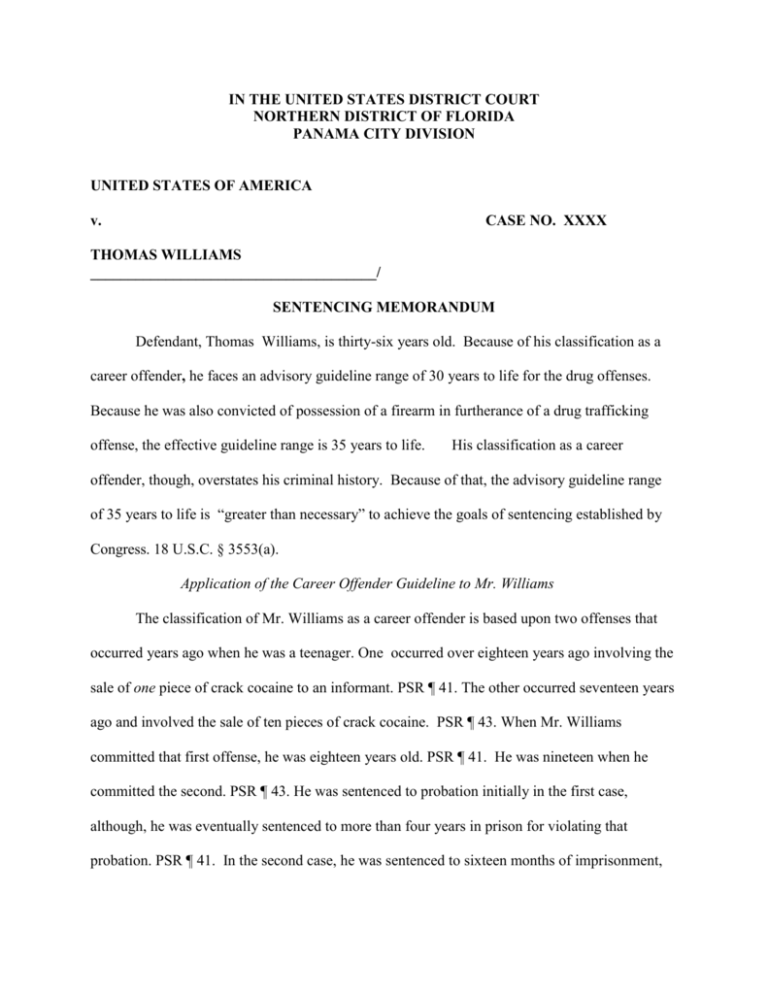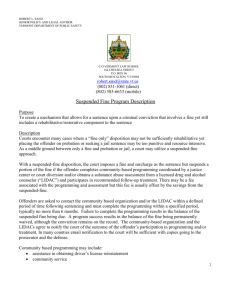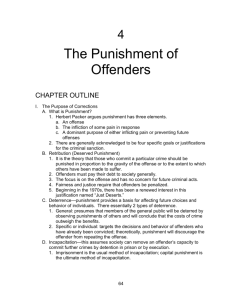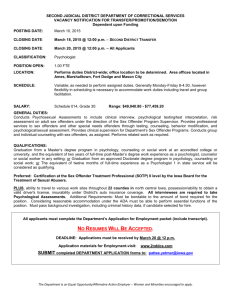IN THE UNITED STATES DISTRICT COURT NORTHERN DISTRICT
advertisement

IN THE UNITED STATES DISTRICT COURT NORTHERN DISTRICT OF FLORIDA PANAMA CITY DIVISION UNITED STATES OF AMERICA v. CASE NO. XXXX THOMAS WILLIAMS ______________________________________/ SENTENCING MEMORANDUM Defendant, Thomas Williams, is thirty-six years old. Because of his classification as a career offender, he faces an advisory guideline range of 30 years to life for the drug offenses. Because he was also convicted of possession of a firearm in furtherance of a drug trafficking offense, the effective guideline range is 35 years to life. His classification as a career offender, though, overstates his criminal history. Because of that, the advisory guideline range of 35 years to life is “greater than necessary” to achieve the goals of sentencing established by Congress. 18 U.S.C. § 3553(a). Application of the Career Offender Guideline to Mr. Williams The classification of Mr. Williams as a career offender is based upon two offenses that occurred years ago when he was a teenager. One occurred over eighteen years ago involving the sale of one piece of crack cocaine to an informant. PSR ¶ 41. The other occurred seventeen years ago and involved the sale of ten pieces of crack cocaine. PSR ¶ 43. When Mr. Williams committed that first offense, he was eighteen years old. PSR ¶ 41. He was nineteen when he committed the second. PSR ¶ 43. He was sentenced to probation initially in the first case, although, he was eventually sentenced to more than four years in prison for violating that probation. PSR ¶ 41. In the second case, he was sentenced to sixteen months of imprisonment, and subsequently earned another year when he violated that probation. PSR ¶ 43. Since committing those two offenses, he has been convicted of four misdemeanors with the last one occurring over six years ago. ¶¶ 44-47. Notably, too, Mr. Williams’s physical condition has faltered in the years since he committed the two offenses that have qualified him as a career offender.1 None of this is to say that Mr. Williams has led a responsible life or has avoided criminal conduct. As recognized in the Presentence Report, he has two serious charges pending in Bay County, and there are arrests for which the charges have been dismissed for one reason or another. Mr. Williams acknowledges, too, that the instant offense is a significant one, albeit one that has been factored into the guideline calculations. Were it not for the career offender classification, Mr. Williams’s guideline range for the offenses would be the 15 years determined by the two minimum mandatory sentences - 10 years for the drug offense and 5 years for the offense of possession of a firearm in furtherance of a drug trafficking offense.2 The net effect is that the career offender classification adds 20 years to the lower end of the guideline range. The defense is gathering Mr. Williams’s medical records and will present a review of them to the Court and the Government prior to Mr. Williams’s sentencing. 2 Mr. Williams has filed an objection to the calculations in the draft Presentence Report. In that report, the probation officer has calculated Mr. Williams’s offense level to be 30 absent the career offender classification. As explained in the undersigned’s May 6, 2011, letter to United States Probation Officer David Reed, the defense maintains that the offense level should be 26. The defense calculations for the marijuana equivalent of 331 kilograms also produces an offense level of 26. The combination of offense level 26 and criminal history category IV produces the guideline range of 92 to 115 months. Because that is less than the 120 months mandatory minimum required by 18 U.S.C. 21 U.S.C. § 841(b)(1)(B), the 120 months becomes the guideline range. The additional 60 months required by 18 U.S.C. § 924(c)(1)(A)(i) results in a guideline range of 180 months. 1 The career offender guideline, however, fails to consider the fact that Mr. Williams’s predicate offenses involve small quantities of cocaine, that he was a teenager at the time, and that they occurred seventeen to eighteen years ago. It is a guideline range that would be the same had he committed the prior offenses within the last five years as a mature adult and had the prior offenses involved significant quantities of controlled substances. 18 U.S.C. § 3553(a) The mandate of 18 U.S.C. §3553(a) is, of course, for the Court to “impose a sentence sufficient, but not greater than necessary, to comply” with the purposes of sentencing set forth in the second paragraph of that same statute. 3 In Rita v. United States, 551 U.S. 338, 347-348 (2007), the Court summarized the now often-cited factors found in that second paragraph: the “(1) offense and offender characteristics; (2) the need for a sentence to reflect the basic aims of sentencing, namely (a) "just punishment" (retribution), (b) deterrence, (c) incapacitation, (d) rehabilitation; (3) the sentences legally available; (4) the Sentencing Guidelines; (5) Sentencing Commission policy statements; (6) the need to avoid unwarranted disparities; and (7) the need for restitution.” See also United States v. Hunt , 459 F.3d 1180, 1182 (11th Cir. 2006). In Mr. Williams’s case, the overstatement of his criminal history that results in his classification as a career offender produces a guideline range that, at the very least, exceeds what is necessary to provide just punishment, deterrence, incapacitation, and rehabilitation, When tested by his Mr. Williams has also objected to the recommendation that he not receive credit for acceptance of responsibility. Were the Court to uphold that objection, the offense level would be 24 and would produce a lower guideline range for the drug offense, 77 to 96 months. 3 “It is worth noting that a district court's job is not to impose a ‘reasonable’ sentence. Rather, a district court's mandate is to impose "a sentence sufficient, but not greater than necessary, to comply with the purposes" of section 3553(a)(2). Reasonableness is the appellate standard of review in judging whether a district court has accomplished its task.” United States v. Foreman, 436 F.3d 638, 644 n.1 (6th Cir. 2006) conduct that led to his two qualifying convictions, it creates, as well, an unwarranted sentencing disparity. The United States Sentencing Guidelines The Supreme Court issued its decision in United States v. Booker, 543 U.S. 220 (2005), more than six years ago. Since then, courts across the country have recognized that there is no presumption favoring the guidelines in the district court. As stated in Rita, “the sentencing court does not enjoy the benefit of a legal presumption that the guideline sentence should apply.” 551 U.S. at 351. Thus, there is “no thumb on the scale in favor of a guideline sentence.” United States v. Wachowiak, 496 F.3d 744, 749 (7th Cir. 2007). See also United States v. Glover, 431 F.3d 744, 752-753 (11th Cir.2005); United States v. Rita, 551 U.S. at 367. (Stevens, J. concurring) (“I trust that those judges who have treated the guidelines as virtually mandatory during the post-Booker interregnum will now recognize that the guidelines are truly advisory.”). Rather, the guideline range serves as the “starting point and the initial benchmark” for the Court’s sentencing decision. Kimbrough v. United States, 552 U.S. 85, 108 (2007). The Career Offender Provision Many courts have recognized that the wide net cast by the career offender provision ensnares the street-level dealer along with drug king pins. See United States v. Moreland, 437 F.3d 424, 435 (4th Cir. 2006) (“[T]he career offender guideline covers a broad range of offenders, encompassing the street-level dealer who handles only small quantities of drugs and the drug king pin or the recidivist with a history of violence.”) Given the disparity in the circumstances of those classified as career offenders, many courts have thought it appropriate to impose sentences below the advisory range established by the career offender guideline. In United States v. Williams, 435 F.3d 1350, 1351 (11th Cir. 2006), the court imposed a 90 month sentence despite the career offender range of 188 to 235 months. There, the court placed much emphasis on the nature of the new offense. Nonetheless, the court also considered what was apparently the relatively minor nature of the prior offenses. Id. at 1353. In other cases, judges have found the classification of individuals as career offenders to be “an area that invites particular scrutiny post-Booker, when the guidelines including the career offender guidelines, are supposed to be advisory.” United States v. Ennis, 468 F.Supp.2d 228, 234 (D.Mass. 2006). In United States v. Fernandez, 436 F.Supp.2d 983, 988-989 (E.D. Wis. 2006), the district court cited a list of pre- and post-Booker cases recognizing that the career offender guideline sometimes calls for a sentence greater than is necessary to satisfy the purposes of sentencing. Courts have, in pre- and post-Booker cases, recognized that the career offender guideline can produce a penalty greater than necessary to satisfy the purposes of sentencing. See, e.g., United States v. Mishoe, 241 F.3d 214, 220 (2d Cir. 2001)("In some circumstances, a large disparity [between the length of the prior sentences and the sentence produced by the guideline] might indicate that the career offender sentence provides a deterrent effect so in excess of what is required . . . as to constitute a mitigating circumstance present 'to a degree' not adequately considered by the Commission."); United States v. Rivers, 50 F.3d 1126, 1131 (2d Cir. 1995)(stating that the district court can depart where the range created by the career offender provision overstates the seriousness of the defendant's record); United States v. Qualls, 373 F. Supp. 2d 873, 876-77 (E.D. Wis. 2005)(stating that in some cases the career offender guideline creates sentences far greater than necessary, such as where the qualifying offenses are designated crimes of violence but do not suggest a risk justifying such a sentence, or where the prior sentences were short, making the guideline range applicable to the instant offense a colossal increase); United States v. Serrano, No. 04-CR-414, 2005 U.S. Dist LEXIS 9782, at *22-25 (S.D.N.Y. May 19, 2005)(imposing non-guideline sentence where defendant's career offender predicates were minor drug offenses on which he served little time); No. 04-4003, United States v. Corber, 2005 U.S. Dist. LEXIS 8927, at *7-9 (D. Kan. Apr. 13, 2005), aff'd, 159 Fed. Appx. 54 (10th Cir. 2005)(finding that the career offender guideline created sentence greater than necessary, considering the nature of the predicate offenses and the instant offense); United States v. Phelps, 366 F. Supp. 2d 580, 590 (E.D. Tenn. 2005)(stating that "it is not unusual that the technical definitions of 'crime of violence' and 'controlled substance offense' operate to subject some defendants to not just substantial, but extraordinary increases in their advisory Guidelines ranges," which in some cases will be greater than necessary, especially where "the defendant's prior convictions are very old and he has demonstrated some ability to live for substantial periods crime free or in cases where the defendant barely qualifies as a career offender"); United States v. Carvajal, No. 04-CR-222, 2005 U.S. Dist. LEXIS 3076, at *15-16 (S.D.N.Y. Feb. 22, 2005)(finding that the career offender guideline produced a sentence greater than necessary under § 3553(a)). In Fernandez, the court imposed a sentence of 126 months rather than the 188 to 235 months called for by the career offender provision. Id. at 991. Although the instant offense involved the sale of a significant quantity of powder cocaine and a firearm was present, the court took note of the minor nature of the defendant’s prior convictions, the length of time that had passed since the prior convictions, and that in the interim the defendant had no criminal history. Id. at 987. In United States v. Williams, 481 F.Supp.2d 1298 (M.D. Fla. 2007), on remand from the Court of Appeals decision at 456 F.3d 1353, the court imposed a sentence of 204 months rather than the 262 to 347 months called for by the career offender guidelines. Id. at 1305, 1303. In doing so, the court stated: In sum, Williams is a street-level dealer of crack cocaine. He is not a king pin, managing a large-scale drug enterprise. While the sale of crack cocaine is a serious offense, severity is a relative concept, and the guideline sentence of thirty years would be grossly disproportionate to the seriousness of the offense. Id. at 1304. In United States v. Gibson, 442 F.Supp.2d 1279, 1285 (S.D. Fla. 2006), where the career offender guidelines advisory range was 360 months to life, the court imposed a sentence of 140 months. In doing so, the court relied upon the relatively small quantity of crack cocaine (22.6 grams) and the nature of the defendant’s prior convictions, which largely “consisted of sales between one and three rocks of crack cocaine.” Id. at 1284. There are additional reasons to closely examine the application of the career offender provision especially to street-level drug dealers such as Mr. Williams. The United States Sentencing Commission has questioned whether the career offender guideline when applied to low-level drug sellers had any appreciable effect on the sales of drugs: The question for policymakers is whether the career offender guideline, especially as it applies to repeat drug traffickers, clearly promotes an important purpose of sentencing. Unlike repeat violent offenders, whose incapacitation may protect the public from additional crimes by the offender, criminologists and law enforcement officials testifying before the Commission have noted that retail-level drug traffickers are readily replaced by new drug sellers so long as the demand for a drug remains high. Incapacitating a low-level drug seller prevents little, if any, drug selling; the crime is simply committed by someone else. U.S. Sentencing Commission, Fifteen Years of Guideline Sentencing, 134 (Nov. 2004). Courts have also recognized that the application of the career offender guidelines can result in a sentence that fails to take into account the Guidelines concern for proportionality in sentencing: The Introduction to the Guidelines notes that a primary purpose of the Guidelines, and indeed, a significant purpose of all sentencing, is not just to avoid disparity in the sentencing of offenders, but also to ensure "proportionality in sentencing through a system that imposes appropriately different sentences for criminal conduct of different severity." U.S.S.G. § 1A1.1, Introductory cmt. (n.3). The drafters could have avoided disparity by sentencing all offenders to life imprisonment no matter what they did. But while that would have made sentencing uniform across the country, it would have been uniformly disproportionate, not to mention grotesquely unfair. In the instant case, Nicholson [who is a career offender] is facing 20 years for drug distribution, a sentence which matches the maximum punishment for the following offenses: Sexual abuse, 18 U.S.C. § 2242; sexual exploitation of children, 18 U.S.C. § 2251; enticement into slavery, 18 U.S.C. § 1583; terrorism, 18 U.S.C. § 2322; torture, 18 U.S.C. § 2340A; kidnapping, 18 U.S.C. § 1201; seditious conspiracy, 18 U.S.C. § 2384; and, biological weapons, 18 U.S.C. § 175c. Likewise, under the Guidelines, selling someone in the slave trade is "only" an offense level 22, U.S.S.G. § 2H4.1 and transmitting top secret national defense information is "just" a 29, U.S.S.G. § 2M3.3, while Nicholson's base offense level is 34. United States v. Ennis, 468 F.Supp.2d at 236. Mr. Williams’s base offense level is, of course, 37, and he is facing, not 20 years, but 30 years for the drug offense. Finally, the Sentencing Commission has also observed the disproportionate application of the career offender provisions to African-Americans: In 2000, there were 1,279 offenders subject to the career offender provisions, which resulted in some of the most severe penalties imposed under the guidelines. Although Black offenders constituted just 26 percent of the offenders sentenced under the guidelines in 2000, they were 58 percent of the offenders subject to the severe penalties required by the career offender guideline. Most of these offenders were subject to the guideline because of the inclusion of drug trafficking crimes in the criteria qualifying offenders for the guideline. (Interestingly, Hispanic offenders, while representing 39 percent of the criminal docket, represent just 17 percent of the offenders subject to the career offender guideline.) Commentators have noted the relative ease of detecting and prosecuting offenses that take place in open-air drug markets, which are most often found in impoverished minority neighborhoods (Tonry, 1995), which suggests that African-Americans have a higher risk of conviction for a drug trafficking crime than do similar White drug traffickers (Tonry, 1995; Blumstein, 2000).4 Of Mr. Williams’s two qualifying offenses both appear to be the product of the sort of “open-air drug markets” discussed by the Sentencing Commission. 4 U.S. Sentencing Commission, Fifteen Years of Guideline Sentencing, 133-34 (Nov. 2004) Conclusion Even when the Sentencing Guidelines were mandatory, sentencing courts were to treat those before them as individuals. See Koon v. United States, 518 U.S. 81, 113 (1996) (“It has been uniform and constant in the federal judicial tradition for the sentencing judge to consider every convicted person as an individual and every case as a unique study in the human failings that sometimes mitigate, sometimes magnify, the crime and the punishment to ensue.”). The decision in Booker and the command of the statute to impose a sentence that is “sufficient, but not greater than necessary,” has given sentencing courts greater latitude to impose a sentence that fits the crime and the person before the court. In Mr. Williams’s case, this Court’s discretion is limited by the applicable mandatory minimum sentences and, accordingly, the Court must impose what is a substantial sentence of 15 years. Nonetheless, there remains a significant difference between the mandatory 15-year sentence and the 35-years-to-life advisory guideline range. Given the length of time that has passed since his two qualifying convictions, his age at the time he committed those offenses, and the relatively minor nature of those offense, Mr. Williams respectfully requests this Court to exercise its discretion and to sentence him to the 15 years required by the mandatory minimum sentencing provisions. CERTIFICATE OF SERVICE I HEREBY CERTIFY that a true and correct copy of the foregoing has been furnished by electronic delivery to the Office of Gayle Littleton, Assistant United States Attorney, this 11th day of May, 2011. Respectfully submitted, s/ Randolph P. Murrell Randolph P. Murrell Federal Public Defender Florida Bar No. 220256 227 N. Bronough St., Suite 4200 Tallahassee, FL 32301 (850) 942-8818 The defendant’s real name has been replaced with a fictional one for purposes of privacy.







